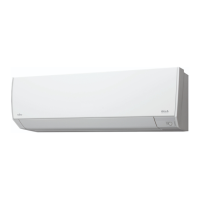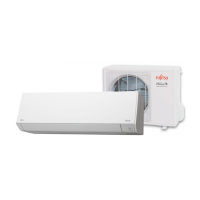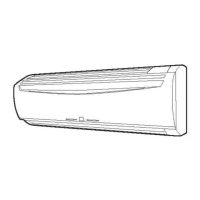Why is water produced from the outdoor unit of my Fujitsu ASU12R1 Air Conditioner?
- VvellisAug 6, 2025
During heating operation, water may be produced from the outdoor unit of your Fujitsu Air Conditioner because of the automatic defrosting process.
Why is water produced from the outdoor unit of my Fujitsu ASU12R1 Air Conditioner?
During heating operation, water may be produced from the outdoor unit of your Fujitsu Air Conditioner because of the automatic defrosting process.
Why doesn't the outdoor unit of my Fujitsu ASU12R1 stop after heating?
The outdoor unit of your Fujitsu Air Conditioner may continue to run even after heating stops to perform automatic defrosting if frost is detected on the unit.
Why is my Fujitsu ASU12R1 Air Conditioner airflow weak or stops?
There are several reasons why the airflow from your Fujitsu Air Conditioner might be weak or stop: * When heating starts, the fan speed is temporarily very low to allow internal parts to warm up. * During heating, the unit may temporarily stop for 7 to 15 minutes for automatic defrosting. * The fan might operate at a very low speed during dry operation or when the unit is monitoring the room's temperature. * In SUPER QUIET mode, the fan operates at a very low speed. * In monitor AUTO operation, the fan also operates at a very low speed.
Why does my Fujitsu ASU12R1 smell?
The smell emitted from your Fujitsu Air Conditioner's indoor unit may be due to room odors, such as those from furniture or tobacco, that have been drawn into the unit.
Why does my Fujitsu ASU12R1 make noise?
Your Fujitsu Air Conditioner might make noise due to these reasons: * During and shortly after operation, you might hear water flowing through the unit's pipes. * For about 2 to 3 minutes after starting, you may notice noise from coolant flowing. * During heating, a sizzling sound may occur occasionally due to automatic defrosting.
Why doesn't my Fujitsu ASU12R1 operate immediately?
Your Fujitsu Air Conditioner may not start immediately under these circumstances: * If the unit is stopped and restarted quickly, the compressor will be disabled for about 3 minutes to prevent fuse issues. * If power is disconnected and then reconnected, a protection circuit will activate for about 3 minutes, preventing operation.
| Cooling Capacity | 3.5 kW |
|---|---|
| Heating Capacity | 4.0 kW |
| Power Supply | 220-240V, 50Hz |
| Refrigerant | R410A |
| Indoor Unit Weight | 9 kg |
| Type | Split System |
| Noise Level (Outdoor Unit) | 50 dB |
Identifies indoor and outdoor unit models for the air conditioner.
States this is an operating manual for future reference.
Visual representation of indoor and outdoor unit parts with labels.
Diagram showing buttons and display of the remote control unit.
Explains the meaning of WARNING, CAUTION, and prohibited operation symbols.
Emphasizes consulting authorized personnel for installation and repairs to avoid hazards.
Advises against prolonged direct airflow and inserting objects into vents.
Highlights the need for ventilation and proper placement away from water and heating sources.
Covers precautions for battery handling and electrical safety during operation and cleaning.
Advises on safe installation distances and avoiding flammable gases near the unit.
Describes automatic mode selection and sleep timer temperature adjustments.
Details Super Quiet operation, swing function, and Power Diffuser.
Mentions removable intake grille and mildew-resistant filter.
Lists and identifies parts of the indoor unit with corresponding numbers.
Lists and identifies parts of the outdoor unit with corresponding numbers.
Identifies remote control buttons, indicators, and display elements.
Instructions for connecting power and inserting batteries into the remote control.
Guide to setting the correct time on the remote control unit.
Steps for mounting the remote control holder on the wall.
How to choose between AUTO, COOL, DRY, HEAT, and FAN modes.
Instructions for adjusting the desired temperature and fan speed.
Explains AUTO mode settings based on room conditions and thermostat.
How to stop the unit and details on Heating, Cooling, and Fan modes.
Guide to setting specific times for unit operation and sequences.
How to cancel, change, or stop operation during timer functions.
How to start the sleep timer and modify its duration and temperature adjustments.
Details how thermostat settings automatically adjust during sleep timer operation.
How to adjust vertical airflow with the remote and horizontal airflow manually.
Important warnings regarding manual adjustment and finger safety.
How to activate, stop, and understand the ranges of swing operation.
How to operate the unit using main unit controls when the remote is unavailable.
Instructions for cleaning the indoor unit and air filter.
Guide for non-use periods and warnings against chemicals.
Advises on regular professional inspections and repairs.
Steps to open, unlock, clean, and reattach the intake grille.
Instructions for properly locking the intake grille back into place.
Guide to removing, cleaning (vacuum or wash), and drying the air filter.
Information on installing and maintaining the optional air cleaning filter.
Checks for immediate operation failure, noise, smells, and mist emission.
Addresses weak airflow, outdoor unit water, and operation during heating stop.
Checks for poor performance, remote setting issues, and blocked grilles/filters.
Emphasizes stopping operation and consulting service for persistent issues or smells.
Explains heating performance reduction and automatic defrost function.
Describes how the unit resumes operation after a power failure.
Specifies recommended indoor/outdoor temperature and humidity for cooling/dry modes.
Specifies recommended indoor/outdoor temperature and humidity for heating mode.
Advises on preventing internal damage, freezing, and proper usage.











